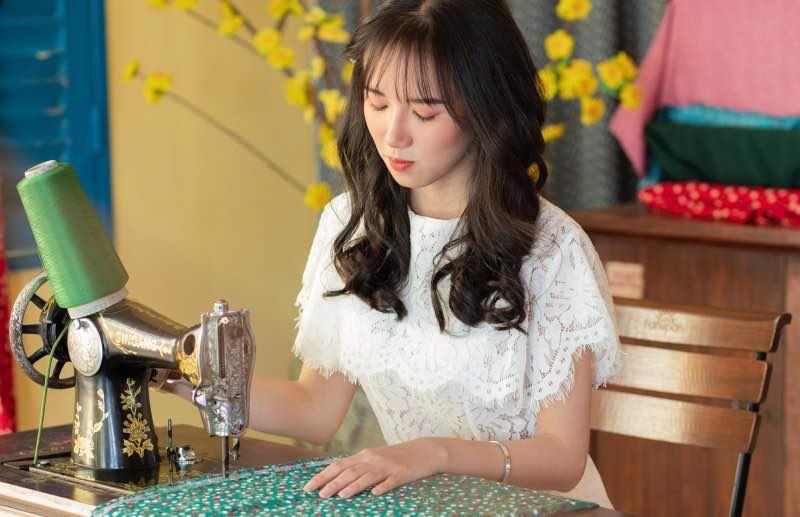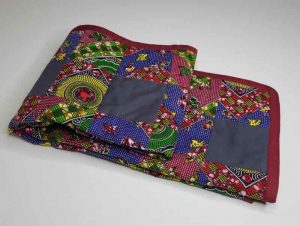You may have rolled your eyes as soon as you saw this title of this post because it is 2021 and sewing a patchwork quilt is not even on your radar. You may also have immediately relegated this project to your retirement years, when you imagine that you will have endless amounts of time to learn to make a quilt. I bet if there was a fun video on a certain app about a patchwork quilt making challenge, you would have watched it and maybe even attempted it. I will do my best to make this project as fun as possible.
Since time is of the essence, we will be sewing a patchwork quilt scarf to keep you warm this winter. This will do two things; minimize the time it will take and also allow you to make something wearable so you can show it off to your friends and family.
What you will need:
- Any fabric you can find and cut it into (75) 5-inch squares (I used leftover cotton fabric)
- 2 packages of Double Fold Bias Tape Quilt Binding
- Backing fabric – 5/8 yard of 60-inch-wide fleece fabric
- Sewing Machine
- All-purpose thread
- Sewing Pins
- Scissors
My patchwork quilt arrangement is fifteen rows consisting of five squares each. If you want a narrower scarf reduce the number of squares across. If you want to make a longer scarf increase the number of rows. Also remember you can choose the size of square you want to use. Try not to make them too small otherwise you will take a lot longer to put the pieces together.
Let’s get started!
Step 1: Arrange five of the squares right sides together then pin and sew together. The seam allowance should be 5/8 inches or 1.5 cm. This should give you the first row of fifteen. If you are using a variety of prints for the squares, first lay them out and arrange them to give you the final pattern sequence you desire. This should be done before pinning and sewing. You should have fifteen rows in all.
Step 2: Press all the seams open.
Step 3: Arrange the rows then pin and sew together. Make sure that you line up the seams accurately.
Step 4: Press all seams open. Now you should have a complete patchwork piece.
Step 5: Now lay out the fleece backing fabric with the right side down. Then lay the patchwork piece over it with the right side up. Pin all around the edges making sure they fit perfectly one on top of the other. Cut around the patchwork piece so that the backing is the same size as the patchwork piece.
Step 6: Baste* the fleece backing and the patchwork piece together. You can use the longest stitch setting on the sewing machine to do this or use a needle thread. Whichever you are more comfortable with.
Step 7: Machine sew along each seam line so that the stitches are not visible. This is called sewing in the ditch. You may need to roll the fabric up so that it is easier to maneuver when using the sewing machine. Turn over to the fleece side to make sure that you have stitched every single square.
Step 8: Press the patchwork quilt side up.
Step 9: Remove the double bias tape quilt binding from the package. Pin one of the edges to the edge of the patchwork quilt in such a way that the edge will be encased in the binding. Pin all the way around the edge. You may need to use both packages if one is not long enough.
Step 10: To join the bias binding open it up and sew the right sides together and press the seam open. Then refold it like it was originally.
Step 11: Sew the binding to the patchwork quilt making sure to stitch in the fold.
Step 12: Following the fold lines, fold the bias binding over the raw edge towards the fleece side. This will encase the raw edge. Then pin the binding in place. Baste* the binding in place if necessary, before machine sewing.
Step 13: With the quilt patchwork side facing up, edgestitch* the binding in place.
Step 14: Finally Press the binding edge to remove any creases and to set the stitches.
Want an Even Bigger Challenge?
Now if this project was successful and you want a bigger challenge, scale the project to sew a patchwork quilt bedspread. In that case add quilt batting between the quilt patchwork and the backing to make it thicker and warmer.
Here is a list of other items that you can make with patchwork quilting:
- Tote bags
- Oven mittens
- Table runners
- Long Skirt Quilt
- Pillow covers
- Place mats
- Wall hangings
- Drapes
- Pencil cases
- Aprons
Happy Patchwork Quilting!
*Basting – temporary stitching that is intended to be removed or hidden in the seam, used to hold a seam or trim in place until it can be permanently sewn together.
*Edgestitch – a straight line of stitches made close to the folded edge of a seam.
Annelouise Bonsalles

